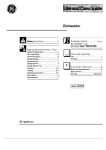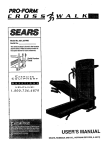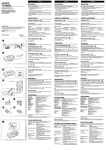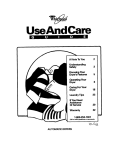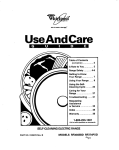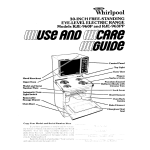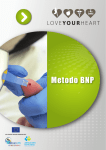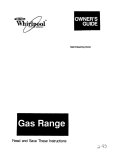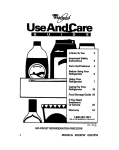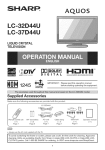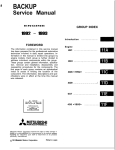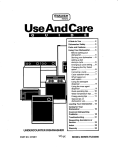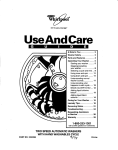Download Whirlpool LLC7244BQ0 User's Manual
Transcript
A Note To You 2 Understandng Washer Safety 3 bowing Your Washer% Features 4 kg Your ia=-asher 5 (Selecting speeds page 7) OtherFeatures 12 Laundry Tips 14 If You Need fiz-fE-or 24 Warranty 28 1400-253-1301 Cdl us with qestions SPEED SELECT AUTONIATIC WASHERS or comments. A Note ToYou Thank you for buying a WhirlpooP appliance. You have purchased a quality, world-class home appli; mce. Years of engineering experience have gone into its manufacturing. To ensure many years of irouble-free operation, we have developed this Use and Care Guide. It is full of valuable information on how to operate and maintain your appliance properly and safely. Please read it carefully. Also, please complete and mail the Ownership Registration Card provided with your appliance. TI ris will help us notify you about any new information on your appliance. Your safety is important to us. This guide contains safety symbols and statements. PI 3ase pay special attention to these symbols and follow any instructions given. Here is a brief explar ation of the use of each symbol. This symbol will help alert you to such dangers as personal injury, bums, fire and electrical shock. Our Consumer Assistance toll-free 24 hours a day. number, v rhich could cause product damage (scratches, dents, etc.) and damage to l’-800-253-1301, is If you have a question concerning your appliance’s operation, or if you need service, first see ‘If You Need Assistance Or Service” on page 24. If you ncled further help, call us. When calling, you will need to know your appliance’s complete model nun tber and serial number. You can find this information on the model and serial number plate (see diagram on page 4). For your convenience, we have included a handy place below for you to recon I these numbers, the purchase date from the sales slip and your dealer’s name and telephone ni mber. Keep this book and the sales slip together in a safe place for future reference. Model Number Der kr Name Serial Number Deeller Phone Purchase Date 2 IMPORTANT SAFETY INSrRUCTiONS To reduce the risk of fire, 4blectrical shock or injury to persons when using your washer, 1allow basic precautions, including the l l l l l l Understanding l l l DD not tamper with the controls. If your hot water has not been used rc cently (usually 2 weeks or longer), b rdrogen gases may build up in your water heater and your hot water pipes. HYDROGEN GAS IS EXPLOSIVE. To PIevent injury or damage, before using yc)ur washer, turn on all hot water faucets al Id allow water to run for several minul es. This will allow gases to escape. Do nl It smoke or use any open flame near ycburfaucet while it is open. Please ... l Have only a qualified person install, rEpair, or replace parts on washer. l Maintain washer properly. . P ,otect washer from the weather and kclep it where the temperature will not fall br glow freezing. l In stall and level washer on a floor that CLIn support the weight.’ l C lnnect washer to the correct 3-prong o~~tlet,electrical supply, water supply, and dr sin.* l G -ound washer properly.* *SCe the Installation Instructions. Read all instructions before using your washer. Do not machine wash or machine dry items cleaned, washed, soaked in, or spotted with wax, paint, gasoline, oil, or other flammable fluids. The fumes can create a fire hazard or explosion. Always hand wash and line dry items containing these materials. Flammable fluids (dry-cleaning solvents, kerosene, gasoline, etc.) should not be used or stored in or near your washer. Do not add flammable fluids to your wash water. These substances give off vapors that can create a fire hazard or explosion. Do not allow children to operate, play with, or crawl on or inside your washer. Supervise children closely when your washer is used near them. Before your washer is removed from service or discarded, remove the lid to prevent accidental entrapment. After starting a cycle, do not reach into the basket unless the Cycle Control Knob is pushed in and all motion stops. your l l responsibiliticzs Store detergent, laundry aids and other materials in a cool, dry place where children cannot reach them (in a locked cabinet if possible). Read and follow instructions on packages of detergent and laundry aids, especially warnings and precautions. Do not wash or dry items that are soiled with vegetable or cooking oil. These items may contain some oil after laundering. Due to the remaining oil, the fabric may smoke or catch fire by itself. DD not use chlorine bleach and ammonia 01 acids (such as vinegar or rust remover) in the same wash. Hazardous fumes can form. . U ?plug power supply cord before al tempting to service your washer. l D I not machine wash fiberglass materials. Small particles can stick to the fabrics washed in following loads and CNSB skin irritation. l - SAVE THESE INS1 RUCTIONS - Knowing Features Your Washer3 The parts and features of your washer are illustrated it I this section. Become familiar with all parts and features before using your washer. NOTE: The drawings in this book may vary from your ‘washer model. They are designed to show the different features of all models covered by this bock. Your model may not include all features. Temperature l elactor gpd wlector Cycle control Load size selector I I I knob I Fabric softener dispensef (under - Agitator Bleach lid) dispenser’ Basket Tub \ Other features not shown: MAGIC CLEW lint filter’ Extra rinse option’ *Available on some models 4 Operating In This Before Section starting Starting your w8shsr or stopping Your Washer Paas ............................. -5 . your washsr .................... .5 Sslscling a load size . . . . . . ..““.........“................... Selecting wash-rinse Salscting agitation-spin tsmperatura sm 8 .. .... .... .... ... . 8 Sel Wing a cyck md time ............................ Usi ng rinse md spin ...................................... Pas30 .18 10 Using drain md spin . . . . . . .. . . . . . . . . . . .. . . . . . . . . . . . . . . . . . 10 Wh st happens in sach cycle . . . . . . . . . . . . . . . . . . . . . . . . . 11 .. . . . . . . . . . . . . . . . . . . . . . . 7 Operating your washer properly ensures maximum wa thing efficiency. This section gives you important information to help you to select a cycle, timlr, and temperature for your wash load. Before starting your washer Add measured detergent. Then place a sorted load in the washer before starting. See page 14 for additional “Before you wash” information. Starting Starting or stopping your 1 NOTE: If your washer has a Consumer Fetlture Guide, remove it and place it in your USCI and Care Guide. your washer washer 1. Select a load size and water temperature. 2. Push in and turn the Cycle Control Knob clockwise. Stop when the indicator on the knob’s outer ring points to the number in the wash cycle you want. The numbers are minutes of wash time. 3. Pull out the Cycle Control Knob. Refer to pages 6-10 for additional information to help you make selections. Stopping washer l l and restarting your To stop the washer at any time, push in the Cycle Control Knob. To restart the washer, close the lid (if necessary) and pull out the Cycle Control Knob. 5 Selecting a load size Your washer has a knob or slide Load Size Selector. Position the Load Size Selector at the setting that corresponds to the size load you want to wash. Select a load size based upon the size of the load and the fabric you are washing. See page 14 for additional loading information. l If your washer has a knob Load Size Selec tor, turn selector to the desired load size. Sattinm If your machine has a slide Load Size Selector, you may set the load size anywhere on or between the small and ex large settings. To change the load size setting after the washer has started to fill, move the Selector to the desired new setting. NOTE: If your washer has RESET on the Load Size Selector, change the load size selection by first moving the Selector to RESET, then to the new load size. may vary with modd l Load l l Sikh doctor with ‘Raset” size tips Items should move freely in the washer. Do not overload the machine or select a load size that is too small for the wash load. Use a large load size setting for best results with permanent press clothes. Selecting wash-rinse lleduce wash time when using a small load z ize setting. Loads with only a few small i ems need less wash time. temperatures Your washer has a knob, CLEAN TOUCH”’ or push button Water Temperature Selector. Match the water temperature to the type of fabric and soils being washed. The top temperature is the wash water and the bottom temperature is the rinse water. NOTE: The Regular cycle features all cold rinses. See the “Water usage guide” on page 18 for more information. l Knob Aodor CLEAN TOUCH wlectoran indicator appears above the water bmperatures wlectd Selecting agitation-spin Ispeeds Your washer has either a knob, CLEAN TOUCH- or push button Speed Selector. Match the agitation and spin speeds to the type of fabric and soil being washed. The top speed is the agitation speed and the bottom speed is the spin speed. NOTE: If you have selected high-speed agitation, the Gentle Wash system helps protect your fabrics by reducing wash agitation speed during the last few minutes of wash agitation in the Heavy, Regular, and Permanent Press cycles. CLEAN TOUCH odactoran inclkdor appear0 PI Ioh button Agitation and spin speeds usage doctor guide The following speed selections are recommended for t etter fabric care. See pages 8 and 9 for suggested cycles. SPEEDS AGITATION SPIN USE FOR LOW LOW Delicate fabrics, bulky knits that wrinkle easily LOW HIGH Delicate fabrics HIGH HIGH Sturdy cottons, blends HIGH LOW Permanent press, synthetic fabrics COMMENTS l Gentle cleaning for light soils 7 Selecting a cycle and time You will find information you need to help you make correct cycle selections in this section. l Pages 8-10: Use the information on these pages to guide you when selecting a wash cycle and time. l Page 11: Use this page to help you understand what happens during a wash cycle. Cycles Heavy cycle The Heavy cycle features the Gentle Wash System (if high-speed agitation is selected) and a longer final spin to shorten drying time. l Use 12 minutes of wash time to clean large loads of sturdily constructed fabrics that are heavily soiled. l Use 6-9 minutes of wash time to clean sturdily constructed fabrics that are lightly to moderately soiled. l Quick cycle (on some models)-Use this cycle to wash sturdily constructed fabrics that are lightly soiled. Regular cycle The Regular cycle features the Gentle Wash system (if high-speed agitation is selected) and a longer final spin to shorten drying time. All rinses are cold. l Use 12 minutes of wash time to clean cotton and linen fabrics that are heavily soiled. l Use 9 minutes of wash time to clean cotton and linen fabrics that are moderately soiled. l Sofhvash cycle (on some models)-Use this cycle for cotton and linen fabrics that are lightly soiled. NOTE: The Regular cycle features all cold rinses. 8 may vary with model Permanent Press cycle The Permanent Press cycle features the Gentle Wash system, a cool-down rinse, and a shortened spin to reduce wrinkling. l Use 9 minutes of wash time to clean permanent press and some synthetic fabrics that are moderately soiled. l Use 6 minutes of wash time to clean permanent press and some synthetics that are lightly soiled. NOTE: The washer pauses briefly during the wash cycle. This is nomal for washer operation. Delicate Permanent praes cycle cycle The Delicate cycle features reduced agitation time for gentle soil removal. A shortened spin reduces wrinkling. l Use 6 minutes of wash time to clean lightly soiled delicate items and washable knits. Super Wash cycle (on some models) Super Wash automatically prewashes the laundry and advances into the Heavy cycle. (The washer does not need to be reset after the Super Wash cycle.) Use this cycle when washing heavily soiled loads that need maximum soil removal. l For proper cleaning use double the amount of detergent recommended for a wash cycle. NOTE: The machine pauses during Super Wash. This is normal for washer operation. Super wash cycle 9 Using rinse and spin NOTE: If your washer has the Extra Rinse option, see page 12. When using extra detergent for heavily soiled clothes, or washing special-care items, you may want an extra rinse and spin. 1. Push Cycle Control Knob in and turn clockwise to RINSE, as illustrated. 2. Pull Cycle Control Knob out. The washer will fill to selected load size, agitate, drain, and spin. Using drain and spin A drain and spin may help shorten drying times for some heavy fabrics or special-care items by removing excess water. 1. Push Cycle Control Knob in and turn clockwise to SPIN, as illustrated. 2. Pull Cycle Control Knob out. The washer will drain and spin. 10 What happens in each cycle When the Cycle Control Knob is set to a number and pulled out, the washer fills (to the selected load size) before agitation and timing start. The washer will begin agitating immediately after filling; agitation can occur with the washer lid up or down. After agitation starts, the Cycle Control Knob turns clockwise until it points to OFF and the cycle ends. The I washer pauses brlefly throughout each cyc le. These pauses are normal for washer opt ration. NOTE: A Gentle Wash system helps protect YOLr fabrics (if high-speed agitation is selected) by I educing wash agitation speed during the lasi few minutes of wash agitation in the Heavy, Reitular and Permanent Press cycles. RINSE WASH 4 F-l l e Li!ikl H hlgtyxed 4 F”] -+- Drain (or partial drain*) No agitation The Permansnl Press cycle partlally drains. Iills. agllates briefly. and drains. l&J Fill Rinse Wash selected time’ agltalbn Is seleded. agilatlon speed Is reduced In Ihe last few minutes of most cycles. This provides belier fabric care. I24 l Fill Drain-No agitation lw Spin-Spray rinse Spin Spin 11 Other Features In This Section Understanding Using the extra rinse option Paw Paw your lint filter . . . .. . . . . . . . . . . . . . . . . . . . . . 12 . . . . . . .. . . . . . . . . . . . . . . . . . . . . 12 Usi rg the fabric soltener Usi rg the chlorine dispenser bleach dispenser . . . . . . . . . . . . 13 . . . . . . . . . . . 18 Your washer may have some of the following features. Understanding the use of the features on your machine will help you efficiently use your washer. Understanding your lint IFilter Your washer has a self-cleaning lint filter (requires no cleaning by you). MAGIC CLEAN@ lint filter This lint filter requires no cleaning. (The lint filter at the bottom of the washer basket cleans itself.) During agitation, wash and rinse water pass over the filter, separating the lint from the water. The lint is then spun away from the filter and out of the system during the spin part of the cycle. If your washer drains into a tub, remove any lint collected in the tub or strainer. Using the extra rinse option You can select an extra rinse in all cycles except the Regular cycle. Indicator on CLEAN TOUCH models Y Extra rinse 12 Using the fabric softenev dispenser Dilute fabric softener with warm water to the cross-bar (on some models) Add detergent and load the basket. Add liquid fabric softener to the dispenser using the amount recommended on the package. Avoid dripping or spilling any fabric softener on the load. 3. Dilute fabric softener with warm water. Fill dispenser with warm water until liquid reaches the cross-bar in the pouring well. 4. Start the washer. Diluted fabric softener will be added to the load during the final rinse. NOTE: Do not stop the washer before the final rinse begins. Staining can occur. 1. 2. Flush dispenser periodically with warm water. To remove the dispenser, grasp the top of the dispenser with both hands. Squeeze and push upward with thumbs to remove. l Clean dispenser by holding under water faucet. Replace after cleaning. NOTE: Do not wash clothes with dispenser removed. Do not add detergent or bleach to dispenser. The dispenser can clog. Add fabric softener and water l Flu! ;h to clean Clean Using the chlorine bleach (on some models) Always measure liquid chlorine bleach. Do not guess. Never use more than 1 cup (250 mL) for a full load. Use less with lower water level settings. Follow manufacturer’s directions for safe use. Use a cup with a pouring spout to avoid spilling. 1. Load the washer. 2. Pour measured chlorine bleach carefully into dispenser. Do not let bleach splash, drip or run down into washer basket. Undiluted bleach will damage any fabric it touches. 3. Start the washer. Bleach will be diluted automatically during wash part of cycle. NOTE: Do not add powdered chlorine or allfabric bleach to the dispenser. The dispenser can clog. dispenser the dispenser Laundry I In This Before Tips Section Page you wash . . . . . . . . . . . . . . . . . . . . . . . . . . . . . . . . . . . . . . . . . . . . . . . 14 Removing problems 15 Caring for your washer.. Water usage guide ............................................ 19 Carl) during Using laundry 19 Sav ng energy Washing stains ............................................... Sob ,ing laundering aids ........................................... special-care items ........................... periods Page . . . . . . . . . . . . . . . . . . . . . . . 22 ............................... of non-use .23 .................. .23 ................................................ 23 .20 This section reviews proper laundering techniques, givljs you additional washing information, and discusses solutions to common laundering problems. l l l l l l l l Before you wash Preparing clothes for washing Close zippers, snaps, and hooks to avoid snagging other items. Remove pins, buckles, and other hard objects to avoid scratching the washer interior. Remove unwashable trim and ornaments. Empty pockets and turn them inside out. Turn down cuffs and brush away lint and dirt. Turn synthetic knits inside out to avoid pilling. Tie strings and sashes so they will not tangle. Mend tears, loose hems and seams. Treat spots and stains. (See pages 15-l 7 for pretreatment and stain removal information.) Stained or wet garments should be washed promptly for best results. Sorting l l l Separate heavily soiled items from lightly soiled ones even if they would -+ normally be washed together. Separate lint givers (towels, chenille) from lint takers (corduliTi roy, synthetics, permanent press). When possible, turn lint givers inside out. Separate dark from light colors, colorfast from noncolorfast. Sort by fabric and construction (sturdy cottons, knits, delicate items). 14 Loading l l l l D ‘op items into washer loosely. Fill to the top of the basket, but do not pack or wrap items around the agitator. Items should move easily through wash water for best . E2 cleaning and wrinkle-free results. Watch for rollover. Items should sink ar Id reappear later. Lclad washer properly. Overloading or pr eking can: +:ause poor cleaning. -i icrease wrinkling. +:reate excessive lint. --\Vear out items faster (because of pilling). Load by the amount of space items take up, not by their weight. M’x large and small items in each load. Load evenly to maintain washer balance. An off-balance load : can make the machine vibrate *- --I’ during spin. To reduce wrinkling, El permanent press and synthetic kr its should have more room to move in the w ster than heavy items (towels, jeans). I Loading suggestions For these suggested full-sized loads, use the hiigchest I( lad size setting. h E (TRA LARGE CAPAC I LARGE CAPACITY WA iERS r Knits 2 slacks 2 blouses 4 shirts 4 tops 2 dresses Delicates 2 camisoles 4 slips 4 panties 2 bras 2 nighties l l removal E 3 1 4 4 2 2 1 l l or soaking Use warm water for soaking or prewashing stained laundry. Hot water can set stains. Stain Tcbwels l(mbath towels l( hand towels 1L wash cloths 1 bathmat !licates :amisoles quilted robe ;lipS Ianties xas lighties laby’s dress Permanent Press 2 double or 1 king size sheet 1 tablecloth 1 dress 1 blouse 2 slacks 3 shirts 2 pillowcases Mixed Load 3 double sheets 4 pillowcases 8 T-shit-Is 6 pair shorts 2 shirts 2 blouses 8 handkerchiefs stains Stained, heavily soiled or greasy items may need to be prewashed or soaked for best results. Soaking helps remove protein-type stains like blood, milk, or grass. Prewashing helps loosen soil before washing. Pre-washing K rits 3 slacks 3 Jlouses 6 shirts 4 ops 4 jresses Mixed Load 2 double or 1 king size sheet 4 pillowcases 6 T-shirts 6 pair shorts 2 shirts 2 blouses 6 handkerchiefs Towels 6 bath towels 8 hand towels 10 wash cloths 1 bathmat Removing H8?avy Work Clothes 3 >air pants 3 shirts 4 >air jeans 1 :overall 1 Iverall Permanent Press 1 double sheet 1 tablecloth 1 dress 1 blouse 2 slacks 3 shirts 2 pillowcases Heavy Work Clothes 2 pair pants 3 shirts 3 pair jeans 1 coverall r WASHERS l rules Most stains are easier to remove when they are fresh. Old or set stains may not come out. Follow package directions for pretreatment products. Before treating any stain, find out . . . 1. What kind of stain it is. 2. What kind of fabric it is and if it is colorfast. (Check label.) l l l 3 How old the stain is. (Washing and drying can set some stains.) S:art with cold or warm water. Hot water can slat some stains. V\‘hen bleach is recommended, use a bleach tt at is safe for the fabric. Dilute chlorine b each. T ,st stain removers on an inside seam or hidden corner of the item to see if the color is rc moved. P It the stained area face down on a paper tc wel or white cloth. Apply the stain remover tc the back of the stain. This can force the stain off the fabric instead of through it. Meat tenderizer or enzyme presoaks help bleak down some protein stains so they are eilsier to remove. U ;e nonflammable dry cleaning solvents in a w #ventilated room. 15 Stain removal STAlN Alcoholic beverage Blood Chewing gum Chocolate or coffee Crayon and candle wax Cream, milk or ice cream Deodorants and antiperspirants Fat, grease or oil Fruit stains Grass or g-n vegetables Ink or ballpoint pen ink 16 guide TO REMOVE These stains turn brown with age, so treat immediately. Sponge or soak fresh stains with cold water. Wash. If stain .emains, soak 15 minutes in a solution of lukewarm water, liquid detergent and a few drops of white vinegar. Rinse. Wash. Rinse immediately or soak in cold wa:er with enzyme presoak for 30 minutes or longer. Rinse. Rub detergent into any remaining stains. Rinse. If stain remains, put a few drops of 3% hydrogen pero. tide on stain for 3-5 minutes. Rinse thoroughly. Wash. Use ice to make gum hard. Scrape off what you can. Sponge with a nonflammable dry cleaning solvent. Let dry. V/ash. Sponge immediately with a nonflamrrable dry cleaning solvent or apply a prewash soil and stain remover. Rins 3. Wash. If stain remains, apply a liquid detergent to stain or soak in warm water with an enzyme presoak. Rewash. Scrape off excess with a dull knife. Place fabric between two blotters or facial tissue. Press with warm iron. Remove’ color stain with nonflammable dry cleaning solvent. Hand wash until stain is gone . If full load is crayon stained, take to cleaners or coin-operated dry cleanin J machine. Sponge with a nonflammable dry cleaning solvent, or a prewash soil and stain remover. Rinse. Wash. Repeat if necessary. If stain remains, apply a few drops of liquid detergent and a few drops of ammonia. Blot dry and rinse. If stain remains, soak in an enzyme presoak. Wash. Llght staln: Treat with liquid detergeltt or your regular laundry detergent. Wash in hottest water safe for fabric. Heavy staln: Place face down on tow el and treat with a paste of ammonia and all-fabric bleach. Let stand for 30 min ltes. Wash in hottest water safe for fabric. Items soiled with vegetable or cookin! oil should not be washed or dried. See vegetable/cooking oil Warning on pace 3. For other types of greasy stains, use one of the methods below: l Use pretreatment stain remover. Fo low label directions. Wash in hottest water safe for fabric. l Use talcum powder to absorb as ml ch grease as possible. Sponge with a nonflammable dry cleaning solvent. Rinse. Wash. l Treat with liquid detergent or rub a tletergent paste on the stain. Wash using hottest water safe for fabric. Fresh stalns: Soak immediately in cc 01water. Wash. If stain remains, cover area with a paste made of all-fabric bleach a few drops of hot water and a few drops of ammonia. Wait 15 to 30 minutes. Vlash. Old stalns: Sponge with white vinegc r. Rinse. Repeat procedure for fresh stains. Soak in warm or cold water with an et zyme presoak for at least 30 minutes, or sponge with denatured alcohol. Wash in water temperature and bleach safe for the fabric. For colored fabrics, check l:olorfastness before applying alcohol. For acetate, sponge with a nonflammable dry cleaning solvent. If stain remains, bleach with 3% hydrogen peroxide. R nse. Rewash. Spray stain with an aerosol hair spray or rubbing alcohol. Sponge stain continuously until all bleeding stops. Let dry. Repeat if necessary. Wash. If stain remains, bleach if safe for fabric. (India and other indelible inks are almost impossible to remove completely.) STAIN Iron or rust Ketchup or tomato products Lipstick Meat juice, egg Mildew Mustard Paint Perspiration Scorch Soft drinks TO REMOVE Colored or noncolorfast items: Apply lemon juice and salt. Place in the sun to dry. Rinse thoroughly. Repeat if ne :essary. White or colorfast Items: Try a rust ‘emover. Test first on inside seam or hem. Some rust removers are not wa:;her safe. Follow package directions. Sponge immediately with a nonflammable dry cleaning solvent or apply a prewash soil and stain remover. Rins!. Wash. If stain remains, apply a liquid detergent to stain or soak in warm water with an enzyme presoak. Rewash. Apply nonflammable dry cleaning sol\ ent or prewash soil and stain remover. Blot with absorbent material. Repeat if necessary. Rinse. If stain still remains, rub with liquid detergent. Wash. Scrape off excess with a dull knife. Sclak in cold or warm water with enzyme presoak at least 30 minutes, or treat f tains with a nonflammable dry cleaning solvent. Wash. Wash in hottest water safe for fabric. f stain remains, soak in warm water and an all-fabric bleach for 15 to 30 minutl?s. Rewash. (Old mildew stains are almost impossible to remove. Mildew fungus destroys or weakens fabrics.) An alternative to bleach is to treat with salt and lemon juice and dry in direct sunlight. Rinse and rewash. Mildew r~ay form if wet or damp laundry remains in your washer for extended periods of t me. To prevent mildew, promptly dry laundry after washing. Treat immediately. Scrape off excess mustard. Sponge with a nonflammable dry cleaning solvent or a prewash soil and stain remover. Rinse. Work liquid detergent and a few drops of vinegar nto stain. Rinse. If stain remains, apply 3% hydrogen peroxide. Rinse and wa ;h. Hand wash paint-stained items. Water base: Treat stains while still wltt. (These paints cannot be removed after they have dried.) Rinse in warm water to flush out paint. Sponge with a nonflammable dry cleaning solvent. Rinse. Wash. 011 base: Scrape off fresh paint. Spor Ige with a nonflammable dry cleaning solvent or treat stain with recommended thinner. While stain is still wet with solvent, rub liquid detergent into it. W;~sh with hottest water safe for fabric. Remove stains before ironing. Perspit ation stains may weaken fabric. Wash or sponge stain thoroughly with deterger It and warm water. If perspiration has changed the color of the fabric, use 011eof the following treatments: Fresh stalns: Apply ammonia to stair . Rinse. Launder to remove ammonia odor. Old stalns: Apply white vinegar to st: in. Rinse. Launder to remove vinegar odor. Severe scorch cannot be removed. Wet stain with 3% hydrogen peroxide. Cover with a dry cloth and press with sn iron as hot as is safe for fabric. Rinse well. Wash. OR Wet with lemon juice and spread in th 3 sun to dry. Wash. Sponge immediately with cold water and alcohol. Heat and detergent may set stain. Water Water tern WASH usage guide erature RINSE HOT 130°F (54°C) or above l l l l WARM 90”-110°F (32”-44°C) COLD COLD 7o”-90°F (21”-32°C) COLD COMMENTS USE FOR Heavy soils Work clothes Sturdy whites and colorfast pastels Diapers l l l Light and moderate soil:’ l Dark or noncolorfast colors 9 Moderately soiled perm;~nent press l Nylons, polyesters, acrylics, silks, woolens l Knits and delicate fabrics l Prewash, soak l Very lightly soiled items l Moderately soiled items if extra detergent is adder 9 Extra sensitive colors (noncolorfast) l Rinsing, for all fabrics l l l l l l l l l To check your hot water temperature wlth a candy or cooklng thermometer: 1. Fill a pan with the hottest water available from the faucet that will fill your washer. 2. Place a candy or cooking thermometer in water to check the temperature. If you do not have a faucet at your wash site, collect water from the faucet closest to your washer. NOTE: In wash-water temperatures colder than 70°F (21 “C): l Detergents do not dissolve well. l Soils are difficult to remove. l Some fabrics will retain wear wrinkles and may have increased pilling. 18 Water Gives best cleaning for heavy soils. Removes oils, perspiration, greasy soils and stains. Prevents graying and yellowing. Safe for most fabric finishes. Less fading and dye bleeding. Reduces wrinkling. Saves hot water. Less effective cleaning than hot or warm water. Use longest wash time in cycle selected. Use liquid detergent, or dissolve powdered detergent in warm water before adding to cold wash water. Pretreat spots, stains and heavy or greasy soils. hardness Many poor washing results can be traced to wish-water hardness. To check your water hardness: l (;ity water-ask your city water company. l \Vell water-call your Cooperative Extension ! ;ervice. Ask for the mineral content in grains-per-gallon or parts-per-million. If your water is 9 or more gnrins-per-gallon or more than 153 parts-permi lion: l (Consider installing a water softener. l I Jse more detergent. l I Jse a packaged water conditioner. l I)0 not use soap. Using laundry aids Follow package instructions when using laundry aids. (See “Removing Stains” on pages 15-l 7 for more information.) Chlorine bleach Use bleach dispenser if your machine has one. (See page 13.) l If your washer does not have a bleach dispenser: 1. Let the washer fill and begin agitating the load. 2. Measure bleach. Never use more than 1 cup (250 mL) for a full load. Dilute measured bleach in 1 quart (1 L) of water. 3. Add bleach to wash cycle so it can be removed in the rinse cycle. Pour bleach around agitator, not directly on load. l Follow directions on care labels. Do not use chlorine bleach on wool, silk, spandex, acetates or some flame-retardant fabrics. l When soaking with chlorine bleach, add detergent to soak water. NOTE: Undiluted bleach will damage any fabric it touches. The damage appears as rips, holes, tears or color loss and may not show up until several washings later. F; lbric l All-fabric l l l l l l l l l softeners lise fabric softener dispenser if your machine has one. Ii your washer does not have a fabric softener dispenser, add diluted fabric softener only in the final rinse. P lways dilute fabric softeners with ‘h to 1 cup ( 25 to 250 mL) warm water. Undiluted fabric s lftener can stain fabrics. Fabric softeners should not be mixed with other laundry products because greasy s :ains may form. If stains form, remove by H etting the stain and rubbing with liquid d 3tergent or a bar of soap. Rewash the s ained item. 130 much fabric softener can make some it ?ms (diapers and towels) nonabsorbent. If tt is happens, use less fabric softener or do n It use it every time. bleach Powdered or liquid all-fabric bleach may be used on all types of fabrics. Do not use all-fabric bleach in the bleach dispenser because it may clog. Detergent l If the recommended amount of normal : udsing detergent creates too many suds or :;uds are present in the rinse water, try a low :udsing detergent. l Using too little detergent is a common cause of laundry problems. Follow manufacturer’s directions. Measure accurately, especially when using ultra detergents. Package directions are usually based on: -moderate water hardness (4-6 grains) -lightly soiled items -normal mix loads. Use more detergent for: -hard water -cooler wash water -full loads -heavily soiled items. Do not judge the amount of detergent to use by the amount of suds in the machine. Low sudsing detergents do not create as many suds as normal sudsing detergents. Fire or Exploslon Hazard Store flammable solvents or liquids away from your washer. l Iry cleaning solvents or fluids should not Se put directly into your washer. l terns treated with solvents should be *insed and air dried before washing in (our washer. Tile fumes from these substances can create a fire hazard or explosion. l Personal Injury Hazard l Idever use chlorine bleach with ammonia )r acids. Hazardous fumes can form. . ICeep stain removal products out of the ,each of children . . preferably in a locked 1:abinet. 19 Washing special-care items Most garments and household textiles have care label!; with laundering instructions. Always follow label directions when they are available. General wasring instructions for some special washables are included in this section. Blankets, electric and woolen Pretreat spots and stains. Select water temperature, cycle, and time according to the type of blanket being washed. Two rinses may be necessary. If manufacturer reco nmends machine washing: 1. Measure blanket before wasfling. 2. Add mild detergent to washel . Fill and agitate briefly to dissolve detergent. 3. Stop washer. Load blanket e’renly around agitator. Soak 10 to 15 minutes. 4. Set Cycle Control Knob to Dnlin and Spin. Start washer. Spin 1 to 2 minutes. 5. Fill washer for final rinse. Sto o washer. Allow to soak. 6. Set Cycle Control Knob to Drain and Spin. Start washer. Allow washer to finish cycle. 7. Lay blanket on flat surface ar d block by gently stretching to original measurement. Woolens tend to shrink more the first time they are washed. This is normal. Curtains, drapes, slipcovers Wash small loads. Crowding wil cause wrinkling. 1. Shake or vacuum to remove oose dirt. 2. Wash following manufacturers instructions. NOTE: Sun-damaged curtains and dn peries will tear whether hand or machine washed. l Replace slipcovers while still s ightly damp. They will dry to fit tightly. l Diapers When using chlorine bleach for !;oaking, add detergent to load. Avoid overuse of fabric softeners. Abs jrbency will be reduced. 1. Rinse immediately. Soak in a solution of lukewarm water and a small amount of detergent until you are ready to wash them. You may wish to use bleach or a special soaki tg product when soaking. 2. Spin excess water from diaps rs before washing. 3. Wash diapers as you would vash white cottons and linens. Elastic, spandex Elastic picks up oil from the hod!‘. Oil can damage elastic. Wash often to help reduce the damage. Use wium water and sufficient detergent to remove oils. Flame-retardant clothing Items will be clearly labeled as flame-retardant. Follow manufacturer’s instructions to retain flame retarc lant qualities. 20 Fiberglass materials Do not wash fiberglass materia s in your washer. Glass particles could stick to the next load and cause skin irritation. Knits Knits are comfortable to wear because they stretch. However, this means that knits are more likely to be : ,tretched and damaged when washed (especially bulky knits). Knits made of synthetic fabrics such as polyester, nylon, and acrylic tend to keep their original shape more than a knit made of cotton or ramie. 1. Close zippers, fasten hooks and eyes to prevent snagging. 2. Wash small loads to reduce oilling and lint. Pillows, stuffed toys Washing feather pillows is not n rcommended unless they are dryer dried. 1. Add detergent, then partially fill washer wfth water; agitate until detergent is dissolved. 2. Place two pillows on oppositc~ sides of the agitator to balance the load. 3. Allow washer to fill complete1 i and continue through the cycle. 4. Stop the washer occasionall) to press air from item(s) being washed. Plastic, rubber Items Treat as delicate items. Wash ir warm water. Wash small items in a mesh bag. Quilts, bedspreads Do not wash cotton-filled comfol ters unless they are quilted or stitched; tucked cotton batting tends to sl p and become lumpy. Scatter rugs 1. Shake or vacuum to remove oose dirt. 2. Wash more than one small n g at a time. If you wash only one rug, add bath towels to balance the lo; rd. A larger rug should be distributed around the agitator to balano 3 the load. Snowsuits, jackets, etc. 1. Wash only one or two items t .t a time. Load evenly around the agitator. 2. Stop the washer occasionally to press air from item(s) being washed. 3. Two rinses may be necessarr. 21 Solving laundering problems Most laundering problems are easily solved if you undtlrstand the cause. Check the following list for problems you may have and possible causes. If you need additional help, check the “Assistance or Service” section of this book. PROBLEM CAUSE Brown, yellow stains l l l Dye transfer l l Gray whites, dingy colors l l l l Greasy looking spots l l l Lint l l l l l Load too wet after spin Shrinking l l l l Snags, rips, holes l l l l l Stiff, rough fabrics (usually cottons) l l l Twisting, tangling l l Wrinkling l l l l Yellow areas (from body oils) 22 l l Chlorine staining Iron in water heater or pipes Iron and manaanese in water Improper sorting Load not immediatelv remove d from washer after end of cycle Improper sorting Water temperature too low Not enough detergent Using soap in very hard wate. (use detergent if you have hard water) Undiluted fabric softener or fs brie softener poured directly on load Fabric softener in wash water Not enough detergent Improper sorting Paper or tissue in pockets Pilling being mistaken for lint Overloading Not enough detergent Cold rinses Lid is opened before spinning is completed Fabric type (some knits stretch during manufacturing-laundering fabric to original size) Care label directions not folloved returns Items damaged before washing Misuse of chlorine bleach Sharp articles not removed from pockets Overloading Fasteners not fastened Using soap in very hard water (use detergent if you have hard water) Not enough detergent Line drying Overloading Improper loading (do not wrap 1large items around agitator) Overloading Load not immediately removed from washer after end of cycle Improper rinse temperature Cycle selection is incorrect (bz sed on fabric type) Water temperature too low Not enough detergent Caring l l l l for your washer Wipe up detergent, bleach, and other spills with a soft, damp cloth or sponge as they occur. Remove hard water deposits using only cleaners labeled as washer safe. If the washer interior needs cleaning (for example, after tinting or dyeing), put 1 cup (250 mL) of chlorine bleach and 2 cups (500 mL) of detergent in the washer. Run through a complete cycle using hot water. If staining occurs on following loads, repeat the process. Sharp or heavy objects can damage your washer. Check pockets for bolts, nuts, etc. Do not lay these objects on your washer after emptying pockets. NOTE: Operate your washer only when you are at home. Care during Winter storage periods or moving of non-use care Install and store your washer where it will not freeze. Because some water stays in the washer, freezing can damage it. If your washer is stored or moved during freezing weather, winterize it. 1. Shut off both water faucets. Disconnect the drain water inlet hoses. 2. Put 1 quart (1 L) of R.V.-type antifreeze in the basket. 3. Run washer on a drain and spin setting (see page 10) for about 30 seconds to mix the antifreeze and water. 4. Unplug power supply cord. Saving Non-use/vacation care 1. I Jnplug power supply cord or turn off f Jectrical power. 2. --urn off water supply leading to your \~asher. This will help avoid accidental f ooding while you are away (for example, tlue to a water pressure surge). energy Use warm or cold wash water for most loads. Use hot water only when washing heavy, greasy soils or whites. l Use cold rinses. l Wash full loads. * Use lower water levels when washing small loads. l To use the washer again: 1. I-lush water pipes and hoses. 2. Iqeconnect water inlet hoses. 3. ‘-urn on both water faucets. 4. Iqeconnect power supply cord. 5. Ijun the washer through a complete cycle \vith 1 cup (250 mL) of detergent to clean [but antifreeze. l l Al’oid rewashing. Use enough detergent; pr streat stains or heavy soils; do not overlo sd; use the cycles and wash times recomm anded for the fabric and soil; sort properly. U:;e your washer during off-peak hoursUEually early morning and late evening. (Ask yc ur power company.) 23 If You Need Ass8istance Or Service 1. Before calling for assistance ... Is your water turned on? RI!!•n!l - Is the power cord plugged in? Have you blown a fuse or tripped thf~ circuit breaker? If you need more help, check the chcart below. PROBLEM Washer will not fill CHE(:K THE FOLLOWING Is the power cord firmly plugged into a live circuit with proper voltage? Has a household fuse blo tvn or circuit breaker tripped? Has a timedelay fuse been used? Are both hot and cold wat sr faucets open? Are the water supply hosts kinked? Is the Cycle Control Knob set and pulled out? Washer does not spin Is the lid closed? Is the power cord firmly pl Jgged into a live circuit with proper voltage? Has a household fuse blolvn or circuit breaker tripped? Has a timedelay fuse been used? Washer stops during a cycle Washer pauses briefly at different times in each cycle. These pauses are normal. Is the power cord firmly pl Jgged into a live circuit with proper voltage? Has a household fuse blo\vn or circuit breaker tripped? Has a timedelay fuse been used? Washer fills and drains without running Is the Cycle Control Knob pointing to a number in the cycle? Washer drains during wash and rinse cycles, or water siphons out Adjust the drain hose so tt at it is higher than the water level in the washer. 4 2. If you need assistance* ... Call WhIrlpool Consumer Assistance Center telephone number. Dial toll-free from anywhere In the U.S.A.: 1-800-253-I 301 and talk with one of our trained consultants. The consultant can instruct you in how to obtain satisfactory operation from your appliance or, if service is necessary, recommend a qualified service company in your area. If you prefer, write to: Mr. William Clark Consumer Assistance Representative Whirlpool Corporation 2000 M-63 Benton Harbor, Ml 49022 Please include a daytime phone number in your correspondence. 3. If you need service* ... Whirlpool has a nationwide network of authorized WhirlpoolSM service companies. Whirlpool service technicians are trained to fulfill the product warranty and provide after-warranty service, anywhere in the United States. To locate the authorized Whirlpool service company in your area, call our Consumer Assistance Center telephone number (see Step 2) or look in your telephone directory Yellow Pages under: l APPLIANCE-HOUSEHOLDMAJOR, SERVICE 6 REPUR -Sea: WhIrlpool Appliances or Atihorized Whiilpcd Service (Exsmpk: XYZ selvice Co.) - WASHING DRYERS, 4. If you need FSP@ replacement parts . . . FSI) is a registered trademark of Whirlpool poration for quality parts. Look for this syn rbol of quality whenever you need a rep acement part for your Whirlpool” appliance. FSP replacement parts will fit right and WOIk right, because they are made to the same exscting specifications used to build every new Wh rlpool appliance. To locate FSP replacement parts in your are 2, refer to Step 3 above or call the Wh rlpool Consumer Assistance Center nur jber in Step 2. COI 5. If you are not satisfied how the problem was solved . . . with . C Intact the Major Appliance Consumer Al:tion Panel (MACAP). MACAP is a group of in dependent consumer experts that voices cc~nsumer views at the highest levels of the major appliance industry. l C Intact MACAP only when the dealer, allthorized servicer and Whirlpool have failed to resolve your problem. Major Appliance Consumer Action Panel 20 North Wacker Drive Chicago, IL 60606 l M 4CAP will in turn inform us of your action. MACHINES A SERYICE 6 REPAIR . See: Whirlpool Appliances or Atihorked Whirlpool Service (ExampkxYZ service Co.) When asklng for help or service: Please provide a detailed description of the problem, your appliance’s complete model and serial numbers and the purchase date. (See page 2.) This information will help us respond properly to your request. Gearcase assembly covered by your warranty l 25 WHIRLPOOL=’ Automatic Washer Warranty LENGTH OF WARRANTY WHIRLPOOL WILL Pk,Y FOR FULL ONE-YEAR WARRANTY From Date of Purchase FSP replacement part:; and repair labor to correct defects in materials or workmanst ip. Service must be provided by an authorized WhirlpoolSM : ;ervice company. LIMITED FIVE-Y EAR WARRANTY From Date of Purchase FSP replacement parts for any part of gearcase assembly if defective in materials or worknanship. The gearcase assembly is shown in the ‘Assistance or Service’ section of this book. FSP replacement parts for any top and lid rust. LIMITED TEN-Y EAR WARRANTY From Date of Purchase FSP replacement of out 3r tub should it crack, or fail to contain water, due to defective ~naterials or workmanship. WHIRLPOOL WILL NOT PAY FOR A. Service calls to: 1. Correct the installation of your washer. 2. Instruct you how to use your washer. 3. Replace house fuses or correct house wiring or pl lmbing. B. Repairs when your washer is used in other than non nal, single-family household use. C. Pickup and delivery. Your washer is designed to be Iepaired in the home. D. Damage to your washer caused by accident, misuse, fire, flood, acts of God or use of products not approved by Whirlpool. E. Any labor costs during the limited warranties. F. Repairs to parts or systems caused by unauthorized modifications made to the appliance. 8-W WHIRLPOOL CORPORATION SHALL NOT BE LIABLE FOR INCIDENTAL OR CONSEQUENTIAL DAMAGES. Some states do not allow the exclusio I or limitation of incidental or consequential damages, so this limitation or exclusion may not apply to you. This warranty gives you specific legal rights, and you may also have other rights which v;~ry from state to state. Outside the United States, a different warranty may app y. For details, please contact your authorized Whirlpool distributor or military exchange. If you need service, first see the “Assistance or Service” section of this book. After checking “Assistance or Service,” additional help can be found by calling our Consumer Assistance Center telephone number, l-800-253-1301, from anywhere in tile U.S.A. PART NO. 3357471 0 1883 WhIrlpool Corporation (D RegIstered Trademark&M Service ME rkof Whirlpool Corporation Printed in U.S.A.


























